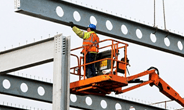Economy

Durable Goods Orders Decrease in January
Written by Sandy Williams
February 27, 2014
Orders for durable goods decreased $2.2 billion or 1.0 percent in January to $225 billion according to the US Census Bureau’s advance report. Orders have been down three of the last four months and followed a 5.3 percent decline in December. The three month moving average fell for the second consecutive month, dropping 1.23 percent in January. The year-over-year growth rate for the 3MMA fell from 4.87 percent in December to 3.48 percent last month. Declining orders in transportation equipment drove the decrease.
The US Census Bureau report reads as follows:
“New orders for manufactured durable goods in January decreased $2.2 billion or 1.0 percent to $225.0 billion, the U.S. Census Bureau announced today. This decrease, down three of the last four months, followed a 5.3 percent December decrease. Excluding transportation, new orders increased 1.1 percent. Excluding defense, new orders decreased 1.8 percent. Transportation equipment, also down three of the last four months, drove the decrease, $4.0 billion or 5.6 percent to $67.3 billion. This was led by nondefense aircraft and parts, which decreased $3.4 billion.
Shipments of manufactured durable goods in January, down two consecutive months, decreased $0.9 billion or 0.4 percent to $232.3 billion. This followed a 1.8 percent December decrease. Machinery, down following five consecutive monthly increases, drove the decrease, $0.9 billion or 2.6 percent to $34.5 billion. Unfilled Orders Unfilled orders for manufactured durable goods in January, up eleven of the last twelve months, increased $0.6 billion or 0.1 percent to $1,060.1 billion. This was at the highest level since the series was first published on a NAICS basis in 1992, and followed a 0.2 percent December increase. Machinery, up nine of the last ten months, drove the increase, $2.0 billion or 1.8 percent to $112.0 billion.
Inventories of manufactured durable goods in January, up nine of the last ten months, increased $1.0 billion or 0.3 percent to $389.1 billion. This was at the highest level since the series was first published on a NAICS basis, and followed a 0.9 percent December increase. Transportation equipment, up twenty of the last twenty-one months, drove the increase, $1.1 billion or 0.9 percent to $123.0 billion.
Nondefense new orders for capital goods in January decreased $3.2 billion or 3.9 percent to $78.3 billion. Shipments decreased $0.8 billion or 1.0 percent to $75.1 billion. Unfilled orders increased $3.2 billion or 0.5 percent to $644.7 billion. Inventories increased $0.5 billion or 0.3 percent to $177.5 billion. Defense new orders for capital goods in January increased $1.6 billion or 26.3 percent to $7.7 billion. Shipments decreased $0.2 billion or 1.9 percent to $9.7 billion. Unfilled orders decreased $2.0 billion or 1.3 percent to $158.8 billion. Inventories decreased $0.4 billion or 1.7 percent to $22.6 billion.”
SMU Note: If you are reading this article on the Steel Market Update website, an interactive chart for Durable Goods Orders can be seen below. If you need help logging into the website please contact us at (800) 432 3475 or by email at info@steelmarketupdate.com.
{amchart id=”88″ Durable Goods Analysis- New Orders and YOY % Change, 3MMA}

Sandy Williams
Read more from Sandy WilliamsLatest in Economy

Steel groups welcome passage of budget bill
Steel trade groups praised the passage of the Big Beautiful Bill (BBB) in Congress on Thursday.

Industry groups praise Senate for passing tax and budget bill
The Steel Manufacturers Association and the American Iron and Steel Institute applauded the tax provisions included in the Senate's tax and budget reconciliation bill.

Chicago PMI dips 0.1 points in June
The Chicago Purchasing Managers Index (PMI) slipped 0.1 points to 40.4 points, in June.

Multi-family pullback drives housing starts to 5-year low in May
US housing starts tumbled in May to a five-year low, according to figures recently released by the US Census Bureau.

Architecture firms still struggling, ABI data shows
Architecture firms reported a modest improvement in billings through May, yet business conditions remained soft, according to the latest Architecture Billings Index (ABI) release from the American Institute of Architects (AIA) and Deltek.
